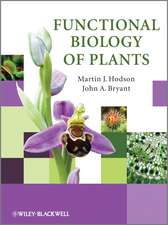The Biology of Reaction Wood: Springer Series in Wood Science
Editat de Barry Gardiner, John Barnett, Pekka Saranpää, Joseph Grilen Limba Engleză Hardback – 22 ian 2014
Trees produce reaction wood to maintain the vertical orientation of their stems and the optimum angle of each branch. They achieve this by laying down fibre cell walls in which differences in physical and chemical structure from those of normal fibres are expressed as differential stresses across the stem or branch. This process, while of obvious value for the survival of the tree, causes serious problems for the utilisation of timber. Timber derived from trees containing significant amounts of reaction wood is subject to dimensional instability on drying, causing twisting, bending and splitting. It is also difficult to work as timber, and for the pulp and paper industry the cost of removing the increased amount of lignin in compression wood is substantial. This has both practical and economic consequences for industry.
Understanding the factors controlling reaction wood formation and its effect on wood structure is therefore fundamental to our understanding of the adaptation of trees to their environment and to the sustainable use of wood.
The topics covered include:
-Morphology, anatomy and ultrastructure of reaction wood
-Cell-wall polymers in reaction wood and their biosynthesis
-Changes in tree proteomes during reaction wood formation
-The biomechanical action and biological functions of reaction wood
- Physical and mechanical properties of reaction wood from the scale of cell walls to planks
-The detection and characterisation of compression wood
-Effects of reaction wood on the performance of wood and wood-basedproducts
- Commercial implications of reaction wood and the influence of forest management on its formation
| Toate formatele și edițiile | Preț | Express |
|---|---|---|
| Paperback (1) | 1216.33 lei 6-8 săpt. | |
| Springer Berlin, Heidelberg – 23 aug 2016 | 1216.33 lei 6-8 săpt. | |
| Hardback (1) | 1222.31 lei 6-8 săpt. | |
| Springer Berlin, Heidelberg – 22 ian 2014 | 1222.31 lei 6-8 săpt. |
Din seria Springer Series in Wood Science
- 18%
 Preț: 1543.84 lei
Preț: 1543.84 lei - 23%
 Preț: 2062.71 lei
Preț: 2062.71 lei - 18%
 Preț: 1824.32 lei
Preț: 1824.32 lei - 18%
 Preț: 2093.60 lei
Preț: 2093.60 lei - 24%
 Preț: 817.70 lei
Preț: 817.70 lei - 18%
 Preț: 1225.16 lei
Preț: 1225.16 lei - 18%
 Preț: 3288.92 lei
Preț: 3288.92 lei - 18%
 Preț: 948.29 lei
Preț: 948.29 lei - 18%
 Preț: 946.87 lei
Preț: 946.87 lei - 15%
 Preț: 643.34 lei
Preț: 643.34 lei - 18%
 Preț: 1122.87 lei
Preț: 1122.87 lei - 18%
 Preț: 1020.30 lei
Preț: 1020.30 lei - 24%
 Preț: 836.40 lei
Preț: 836.40 lei - 20%
 Preț: 569.47 lei
Preț: 569.47 lei - 15%
 Preț: 638.89 lei
Preț: 638.89 lei - 15%
 Preț: 636.30 lei
Preț: 636.30 lei - 15%
 Preț: 635.31 lei
Preț: 635.31 lei - 18%
 Preț: 878.05 lei
Preț: 878.05 lei - 15%
 Preț: 646.43 lei
Preț: 646.43 lei - 18%
 Preț: 1004.67 lei
Preț: 1004.67 lei - 18%
 Preț: 894.03 lei
Preț: 894.03 lei - 15%
 Preț: 658.70 lei
Preț: 658.70 lei - 15%
 Preț: 641.53 lei
Preț: 641.53 lei - 18%
 Preț: 950.84 lei
Preț: 950.84 lei - 18%
 Preț: 783.35 lei
Preț: 783.35 lei - 15%
 Preț: 645.79 lei
Preț: 645.79 lei - 24%
 Preț: 880.78 lei
Preț: 880.78 lei -
 Preț: 388.13 lei
Preț: 388.13 lei - 18%
 Preț: 780.82 lei
Preț: 780.82 lei - 18%
 Preț: 891.65 lei
Preț: 891.65 lei
Preț: 1222.31 lei
Preț vechi: 1490.62 lei
-18% Nou
Puncte Express: 1833
Preț estimativ în valută:
233.88€ • 244.20$ • 193.57£
233.88€ • 244.20$ • 193.57£
Carte tipărită la comandă
Livrare economică 04-18 aprilie
Preluare comenzi: 021 569.72.76
Specificații
ISBN-13: 9783642108136
ISBN-10: 364210813X
Pagini: 350
Ilustrații: IX, 274 p. 77 illus., 36 illus. in color.
Dimensiuni: 155 x 235 x 25 mm
Greutate: 0.58 kg
Ediția:2014
Editura: Springer Berlin, Heidelberg
Colecția Springer
Seria Springer Series in Wood Science
Locul publicării:Berlin, Heidelberg, Germany
ISBN-10: 364210813X
Pagini: 350
Ilustrații: IX, 274 p. 77 illus., 36 illus. in color.
Dimensiuni: 155 x 235 x 25 mm
Greutate: 0.58 kg
Ediția:2014
Editura: Springer Berlin, Heidelberg
Colecția Springer
Seria Springer Series in Wood Science
Locul publicării:Berlin, Heidelberg, Germany
Public țintă
ResearchCuprins
Introduction.- Morphology, Anatomy and Ultrastructure of Reaction Wood.- Cell Wall Polymers in Reaction Wood.- The Molecular Mechanisms of Reaction Wood Induction.- Biomechanical Action and Biological Functions.- Physical and Mechanical Properties of Reaction Wood.- Detection and Grading of Compression Wood.- Effects of Reaction Wood on the Performance of Wood and Wood-based Products.- Commercial Implications of Reaction Wood and the Influence of Forest Management.
Textul de pe ultima copertă
The book is an essential reference source on reaction wood for wood scientists and technologists, plant biologists, silviculturists, forest ecologists, and anyone involved in the growing of trees and the processing of wood. It brings together our current understanding of all aspects of reaction wood, and is the first book to compare and discuss both compression wood and tension wood.
Trees produce reaction wood to maintain the vertical orientation of their stems and the optimum angle of each branch. They achieve this by laying down fibre cell walls in which differences in physical and chemical structure from those of normal fibres are expressed as differential stresses across the stem or branch. This process, while of obvious value for the survival of the tree, causes serious problems for the utilisation of timber. Timber derived from trees containing significant amounts of reaction wood is subject to dimensional instability on drying, causing distortion and splitting. It is also difficult to work as timber, and for the pulp and paper industry the cost of removing the increased amount of lignin in compression wood is substantial. This has both practical and economic consequences for industry.
Understanding the factors controlling reaction wood formation and its effect on wood structure is therefore fundamental to our understanding of the adaptation of trees to their environment and to the sustainable use of wood.
The topics covered include:
-Morphology, anatomy and ultrastructure of reaction wood
-Cell-wall polymers in reaction wood and their biosynthesis
-Changes in tree proteomes during reaction wood formation
<-The biomechanical action and biological functions of reaction wood - Physical and mechanical properties of reaction wood from the scale of cell walls to planks
-The detection and characterisation of compression wood
-Effects of reaction wood on the performance of wood and wood-based products
- Commercial implications of reaction wood and the influence of forest management on its formation
Trees produce reaction wood to maintain the vertical orientation of their stems and the optimum angle of each branch. They achieve this by laying down fibre cell walls in which differences in physical and chemical structure from those of normal fibres are expressed as differential stresses across the stem or branch. This process, while of obvious value for the survival of the tree, causes serious problems for the utilisation of timber. Timber derived from trees containing significant amounts of reaction wood is subject to dimensional instability on drying, causing distortion and splitting. It is also difficult to work as timber, and for the pulp and paper industry the cost of removing the increased amount of lignin in compression wood is substantial. This has both practical and economic consequences for industry.
Understanding the factors controlling reaction wood formation and its effect on wood structure is therefore fundamental to our understanding of the adaptation of trees to their environment and to the sustainable use of wood.
The topics covered include:
-Morphology, anatomy and ultrastructure of reaction wood
-Cell-wall polymers in reaction wood and their biosynthesis
-Changes in tree proteomes during reaction wood formation
<-The biomechanical action and biological functions of reaction wood - Physical and mechanical properties of reaction wood from the scale of cell walls to planks
-The detection and characterisation of compression wood
-Effects of reaction wood on the performance of wood and wood-based products
- Commercial implications of reaction wood and the influence of forest management on its formation
Caracteristici
This book brings together our current understanding of all aspects of reaction wood The first book to discuss together both compression wood and tension wood Written by international experts Includes supplementary material: sn.pub/extras










